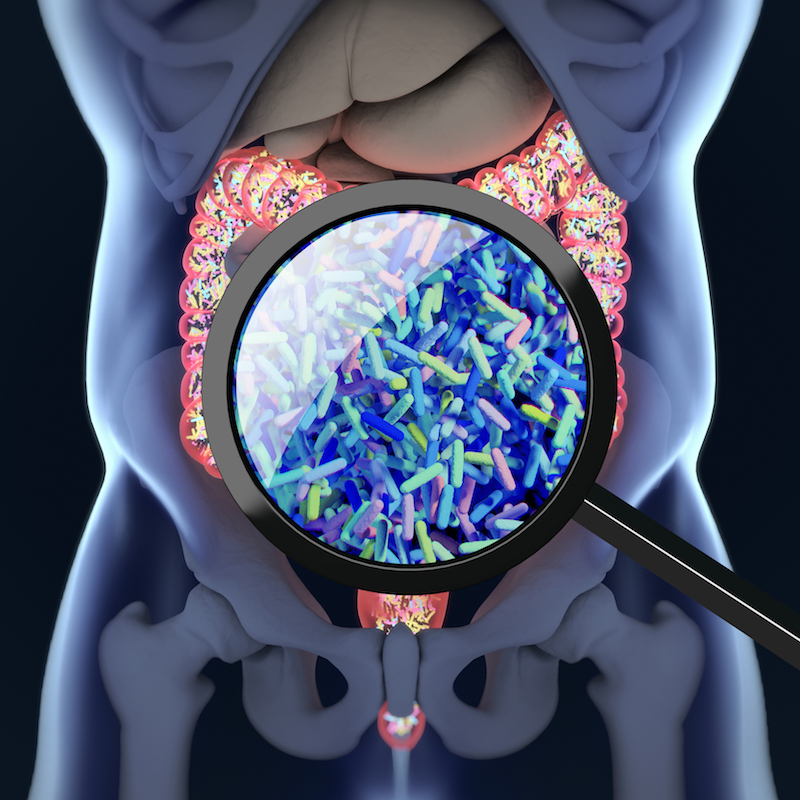Microbiome and Nutrition
The complex community of bacteria, yeasts and viruses living in our intestines, collectively known as the gut microbiome, is shaped, in part, by what we eat. Genetics, environment, and other factors also influence an individual’s microbial community. Research at the NRI investigates these complex relationships and their impact on disease risk. We use animal models and bioinformatics to study the associations between nutritional metabolites, gut microbiome, and health. What happens in the gut doesn’t stay in the gut. Your microbiome can play a role in cardiovascular disease, obesity and diabetes, and even cancer. Our team envisions a future where analysis of your microbiome can determine disease risk, and medical foods can be prescribed to treat and prevent disease by regulating the microbiome.
Publications
Microbiome and Nutrition Publications
2020
Population studies of TMAO and its precursors may help elucidate mechanisms. Meyer K
2019
Association of dietary patterns with the gut microbiota in older, community-dwelling men. Meyer K
2018
Meta-analysis of human genome-microbiome association studies: the MiBioGen consortium initiative. Meyer K
Human microbiota, blood group antigens, and disease. Sumner S
2017
Trimethylamine N-Oxide, the Microbiome, and Heart and Kidney Disease. Zeisel S
2016
Diet and Gut Microbial Function in Metabolic and Cardiovascular Disease Risk. Meyer K
Antibiotic-mediated gut microbiome perturbation accelerates development of type 1 diabetes in mice. Sumner S
Related News
Tissue-specific insulator function at H19/Igf2 revealed by deletions at the imprinting control region
Tissue-specific insulator function at H19/Igf2 revealed by deletions at the imprinting control region.
Ideraabdullah FY, Thorvaldsen JL, Myers JA, Bartolomei MS.
Hum Mol Genet. 2014 Dec 1;23(23):6246-59. doi: 10.1093/hmg/ddu344. Epub 2014 Jul 2.
PMID: 24990148
Favorable Modulation of Benign Breast Tissue and Serum Risk Biomarkers Is Associated with >10% Weight Loss in Postmenopausal Women
Favorable modulation of benign breast tissue and serum risk biomarkers is associated with > 10 % weight loss in postmenopausal women.
Fabian CJ, Kimler BF, Donnelly JE, Sullivan DK, Klemp JR, Petroff BK, Phillips TA, Metheny T, Aversman S, Yeh HW, Zalles CM, Mills GB, Hursting SD.
Breast Cancer Res Treat. 2013 Nov;142(1):119-32. doi: 10.1007/s10549-013-2730-8. Epub 2013 Oct 19.
PMID: 24141897
Calorie restriction and cancer prevention: a mechanistic perspective
Calorie restriction and cancer prevention: a mechanistic perspective.
Hursting SD, Dunlap SM, Ford NA, Hursting MJ, Lashinger LM.
Cancer Metab. 2013 Mar 7;1(1):10. doi: 10.1186/2049-3002-1-10.
PMID: 24280167 [PubMed]
Effects of Calorie Restriction and Diet-Induced Obesity on Murine Colon Carcinogenesis, Growth and Inflammatory Factors, and MicroRNA Expression
Effects of calorie restriction and diet-induced obesity on murine colon carcinogenesis, growth and inflammatory factors, and microRNA expression.
Olivo-Marston SE, Hursting SD, Perkins SN, Schetter A, Khan M, Croce C, Harris CC, Lavigne J.
PLoS One. 2014 Apr 14;9(4):e94765. doi: 10.1371/journal.pone.0094765. eCollection 2014.
PMID: 24732966
Calorie restriction decreases murine and human pancreatic tumor cell growth, nuclear factor-κB activation, and inflammation-related gene expression in an insulin-like growth factor-1-dependent manner
Calorie restriction decreases murine and human pancreatic tumor cell growth, nuclear factor-κB activation, and inflammation-related gene expression in an insulin-like growth factor-1-dependent manner.
Harvey AE, Lashinger LM, Hays D, Harrison LM, Lewis K, Fischer SM, Hursting SD.
PLoS One. 2014 May 7;9(5):e94151. doi: 10.1371/journal.pone.0094151. eCollection 2014.
PMID: 24804677
NSAID use reduces breast cancer recurrence in overweight and obese women: role of prostaglandin-aromatase interactions
NSAID use reduces breast cancer recurrence in overweight and obese women: role of prostaglandin-aromatase interactions.
Bowers LW, Maximo IX, Brenner AJ, Beeram M, Hursting SD, Price RS, Tekmal RR, Jolly CA, deGraffenried LA.
Cancer Res. 2014 Aug 15;74(16):4446-57. doi: 10.1158/0008-5472.CAN-13-3603.
PMID: 25125682

